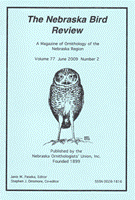Nebraska Ornithologists' Union

Nebraska Bird Review
Date of this Version
6-2016
Document Type
Article
Citation
Brogie, “The Mute Swan in Nebraska: History and Current Status,” from Nebraska Bird Review (June 2016) 84(2).
Abstract
Mute Swans (Cygnus alar) were introduced into North America during the late 1800s as decorative waterfowl and have established feral populations (Ciaranca et al. 1997). Currently, the range of wild populations of Mute Swans in North America includes the Atlantic Coast from Maine to South Carolina and the Great Lakes, with the exception of Lake Superior where it is not established (Baldassarre 2014). The current total North American population is estimated to be 22,000–25,000 (Baldassarre 2014), and populations continue to increase (Petrie and Francis 2003). Indeed, the growing concern over burgeoning numbers has resulted in many states and municipalities implementing programs and procedures to reduce their Mute Swan populations.
As wild populations of Mute Swans continue to increase, there is an increased probability naturally occurring vagrants may reach Nebraska. A central challenge, though, is distinguishing wild vagrants from escaped captive birds, particularly when evidence is limited and usually circumstantial. We believe understanding the occurrence of wild Mute Swans in Nebraska is important for two reasons. First, tracking putative wild Mute Swans provides potentially useful data for state and local agencies that are also monitoring the situation. Second, the Nebraska Ornithologists' Union Records Committee (NOURC) is charged with maintaining the Official List of Birds of Nebraska, and the question of provenance is critically important when evaluating whether a species' record should or should not be accepted. Here we review the species' status in the Midwest and Nebraska and provide guidance to governmental entities and NOURC on how individual records in Nebraska should be evaluated to determine wild provenance. We also review Nebraska reports and identify those which we believe are wild birds using the aforementioned guidance.


Comments
Copyright 2016 Nebraska Ornithologists’ Union. Used by permission.